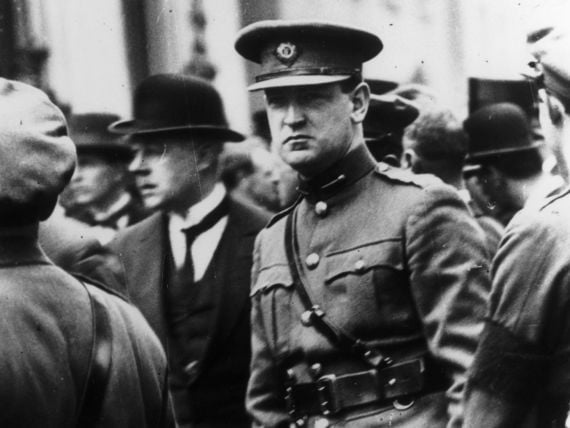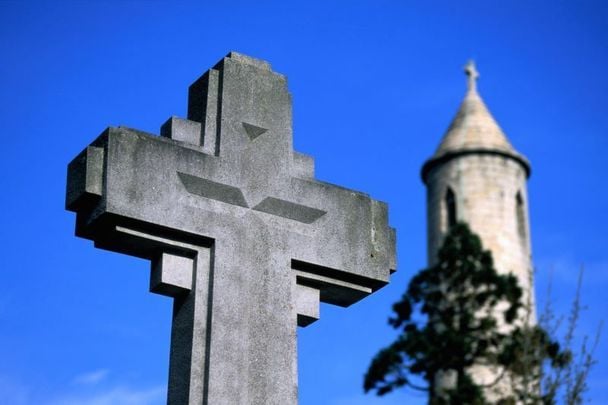On August 22, 1922, Michael Collins was killed. Clearly, as this woman's dedication illustrates, his loss is still felt today.
Irish revolutionary leader Michael Collins was killed on August 22, 1922, and despite their apparent lack of connection, a French woman visited his grave in Glasnevin cemetery every year, for the last 20-plus years.
A mysterious French lady will, we hope get to visit Michael Collins' grave once again this year, continuing a 20-year tradition since she fell in love with the Irish revolutionary after watching the movie "Michael Collins."
She is known as the “Mysterious French Lady” and she appears like clockwork at his grave and lays them down gently before saying a prayer. The woman has been identified as Veronique Crombie a lecturer at the French National Museum who admits to a passionate love for the Irish revolutionary.
The academic explained her love for the patriot after she saw the movie.
"The draw of seeing the Neil Jordan (director) film three years after it was released appeared to me that it was more than an excellent actor giving a great performance, Michael's life story was finally being told [to the world]," explains the intensely private woman.
She told the Sunday Independent, in 2015, that she could not explain the magnetism and draw that Collins has on her. Veronique told the Sunday Independent how she was attending an Indian classical dance workshop in the south of France in August 2000 when she felt the inexplicable need to rush to a nearby cathedral and light a candle for Collins.

Michael Collins.
“On the 22nd, the date he was shot dead, was the decisive moment which helped me understand that definitely, sooner or later I would have to go to Ireland to know more and that going to his grave would show me the way. That Michael himself was drawing me to continue on his story,” she said.
“I’m not the only one who feels that way, my friend, author Chrissy Osborne, told me time and again, when she published her first book about Michael, 'Michael Collins Himself' and also the second one, 'Michael Collins, A Life in Pictures,' that she had always felt that it was Michael who wanted those two books to be written and published because both were a different approach to recounting his life."
Having no Irish connections that she knows of, she cannot explain why this "draw" to mark and carry on his name has taken such a hold. But her journeys to Ireland have created friendships that carry the history of the Cork man who died 98 years ago.
"The amazing thing was indeed that Mercier Press immediately agreed and wanted to go ahead when Chrissy contacted them to talk about her project, even though she was not a historian, had never written a book and wasn't even a journalist.
Veronique also added: "Amazingly, that is also what I felt when I saw 'Michael Collins - a Musical Drama,' in 2009 . . . The musical was just fantastic, I know it was very special for Bryan Flynn who wrote it and Eoin Cannon who played the part on the three occasions I saw it and gave a fabulous performance."
All three are now good friends. Finally, visiting Collins's grave was a powerful moment for Veronique.
"It is difficult to find words to describe how I felt. It was emotional and tears welled up in my eyes but I didn't cry and I wasn't afraid. It was the start of something that is still with me. When a person dies young, an energy is left behind. An energy surrounding things left undone. Speaking to relatives of Michael, they say they feel the same."
So many strangers have now become firm friends due to the politician's and soldier's legacy. Bumping into men who—without being asked or seeking recompense—care for his grave now becomes something of a reunion for Veronique.
"The selfless devotion of Denis Lenihan who has kept Michael's grave for years. Two others, both former army men, James and Ronnie helped Denis out with cleaning the grave and bringing fresh flowers every week.
"I suppose what I do appears more spectacular because it comes from a foreigner but their work shouldn't go unnoticed. Now other people are placing flowers on his grave."
Since her first trip to Dublin, she has become involved in a campaign to Save Moore Street and preserve it as a National Monument. These are the houses where the leaders of the 1916 Rising took shelter when they had to evacuate the GPO and where they made the decision to surrender. It is hoped to create an interpretive center out of the houses.
"The Hewitt sisters at Rosary Florists do a great job for me on preparing the floral arrangements for Collins's grave. It happens sometimes that I ring them early in the morning saying: 'Sorry to ring you so early but I woke up this morning knowing that Michael needed something, can you have a few red roses delivered to the grave asap?' and there is never a problem.
"Usually I realize in an afterthought that the day is a date of some significance in his life."
Mary Hewitt said that visitors to the grave and callers to the florists are intrigued by the French woman's commitment to the memory of Collins and her devotion to his legacy. A legacy that has formed a part of modern-day Irish politics.
* Originally published in 2015, updated in 2022.




Comments